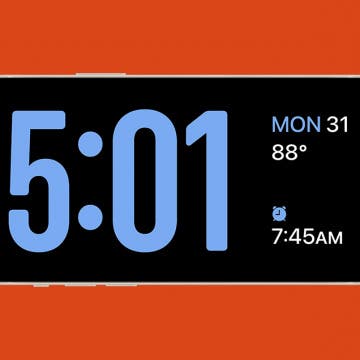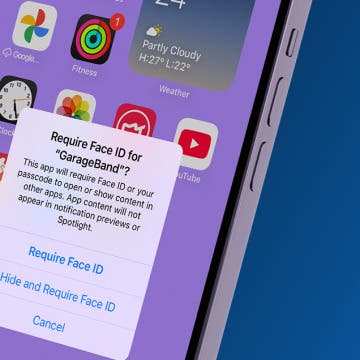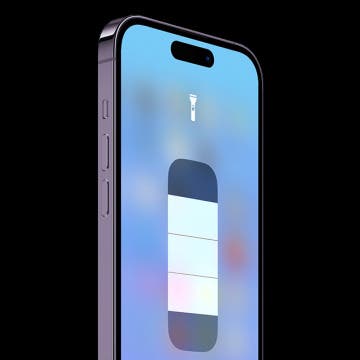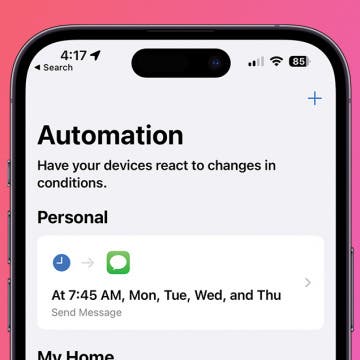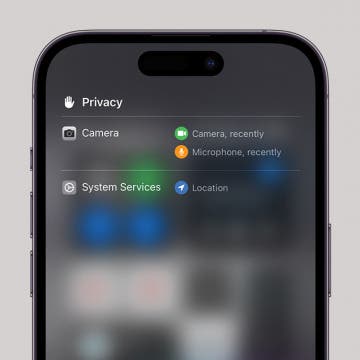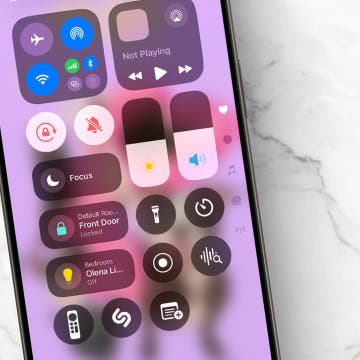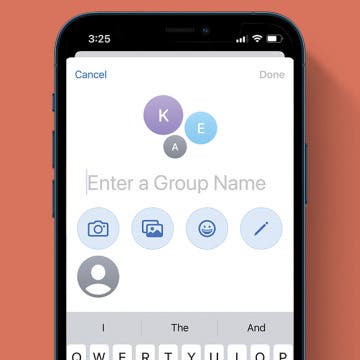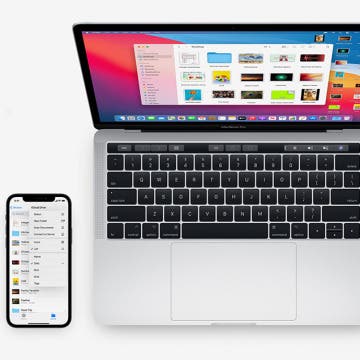What to Know
- The latest iPhone 16 lineup is available starting September 20, 2024.
- The iPhone 16 Pro & Pro Max are the most powerful iPhones in the current lineup.
- For a more budget-friendly option, the iPhone SE, 14, and 15 are also available.
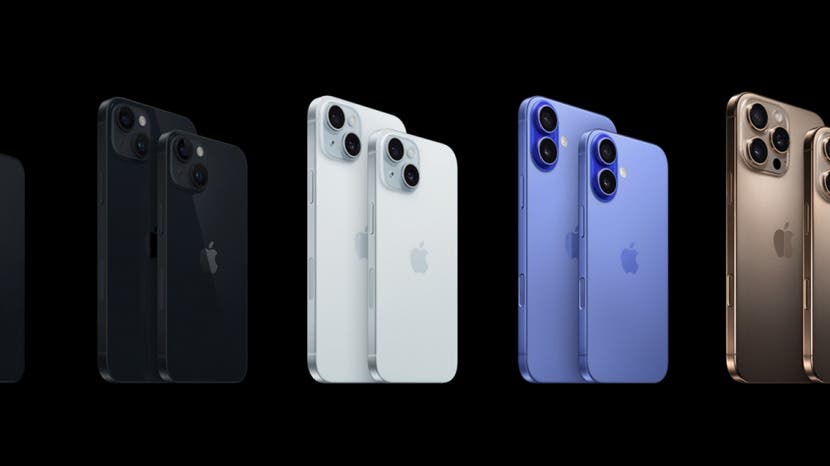
Has your trusty old iPhone finally bit the dust? Or are you finally making the switch from Android? Whatever your situation, if you're in the market for a new iPhone, you're probably a little overwhelmed by the choices. From the new iPhone 16 line to the third-generation iPhone SE, we're here to help you compare iPhones and cut through the noise, ensuring you get the right iPhone.
Jump To:
In this guide, we'll compare the iPhone models available from Apple, from the new iPhone 16 Pro Max to the third-generation iPhone SE. We'll cover price and specs like size and display, camera details, and more, but before we dive in, we'll also go over a glossary of terms to help you understand what it means when an iPhone has "LiDAR" or an "XDR display." Let's jump in.
Terms to Help You Pick the Best iPhone
LiDAR: What does LiDAR stand for? It stands for "Light Detection and Ranging." This technology uses light from a laser to detect objects and determine how far away they are. LiDAR can do a lot, but for most iPhone users, the primary benefits of an iPhone with LiDAR are that it will help take better photos in low light and at night, and it will improve augmented reality (AR) experiences, as LiDAR will help your iPhone get a more accurate picture of its immediate surroundings.

MagSafe: MagSafe technology has been around since 2006, but until recently, it was mostly known as the technology used in older Mac laptop chargers. You remember the chargers that magnetically attach to MacBooks, right? Well, MagSafe is back, and now it's in iPhones! MagSafe's magnetic properties are now built right into iPhones and enable MagSafe-compatible wireless charging and other MagSafe-compatible accessories, like card holders and cases.
Retina: Retina is Apple's proprietary term to describe its displays with higher pixel density. Because the pixels in Retina displays are smaller, the overall appearance becomes sharper, smoother, and well, less pixelated. Can't see the individual pixels no matter how close you get to your iPhone's screen? Thank your Retina display. Terms like Liquid Retina and Super Retina also proprietary marketing terms. The most important thing for you to know about the difference between Liquid Retina and Super Retina is that Liquid Retina screens use Liquid Crystal Display (LCD), while Super Retina screens use organic light-emitting diode (OLED) displays. Super Retina XDR displays will see improved brightness, contrast, and color compared to Liquid Retina displays.
Wide, Ultra Wide, & Telephoto cameras: If you're confused about what the different cameras do on iPhone models with more than one rear-facing camera, here's what you need to know: The Wide camera is the one that you will use most often. It will take your standard pictures, no zoom involved. The Ultra Wide lets you zoom out to capture more of the scene in front of you with your camera, while the Telephoto lens lets you do the opposite and zoom in, capturing closer shots in greater detail.

Which Model Is Right for Me?
So when is the new iPhone coming out? The good news is, you can get your hands on any of the iPhone 16 models any time after September 20, 2024. To learn more about the new iPhones and how to use them, sign up for our Tip of the Day newsletter. Now that you know some key terms, let's dive into the iPhone lineup. There are currently eight available models on the Apple store. Let's walk through the pros and cons of each to find the best iPhone to suit your needs. Something to consider when purchasing an iPhone: a more expensive model often has a higher resale value. For example, you can still trade in last year's iPhone 15 Pro for $520 and put that towards a new iPhone model. This can make a significant difference in your budget and purchasing decisions!
iPhone 16 Pro & Pro Max
- Price: from $999 (15) & $1199 (15 Plus)
- Size & Display: 6.3" Super Retina XDR display (16 Pro) & 6.9" Super Retina XDR display (16 Pro Max)
- Camera: 48 MP Main, 48 MP Ultra Wide, 12 MP 5x Telephoto
- Chip: A18 Pro
- Capacity options: 128 GB (16 Pro Only), 256 GB, 512 GB, 1 TB
- Colors: Black Titanium, White Titanium, Natural Titanium, Desert Titanium
This is it: The ultimate iPhone. The iPhone 16 Pro. It offers the longest battery life (up to 27 hours of video playback on the Pro and 29 hours on the Pro Max) and has the latest A18 Pro chip. It also has the Camera Control button found on the base iPhone 16 models, which can open and control the camera. Speaking of the camera, if you want to know which iPhone has the best camera, this is the one to get. The increase in the level of image detail is impressive thanks to the 48 MP lenses on both the main camera and the Ultra Wide. You'll be able to take clearer, brighter, more colorful photos and videos in any lighting condition. If you want the best iPhone Apple has to offer and money is no object, this is the phone for you. If you love iPhone photography and cinematography, you'll definitely want to invest in one of the Pro models.
iPhone 16 & iPhone 16 Plus
- Price: from $799 (16) & $899 (16 Plus)
- Size & Display: 6.1" Super Retina XDR display (16) & 6.7" Super Retina XDR display (16 Plus)
- Camera: 48 MP Main, 12 MP Ultra Wide
- Chip: A18
- Capacity options: 128 GB, 256 GB, 512 GB
- Colors: Black, White, Pink, Teal, Ultramarine
The iPhone 16 and 16 Plus are some of the most powerful iPhones currently available. With the upgraded A18 chip, they're faster and more responsive than ever. This new chip also means the iPhone 16 lineup is compatible with Apple Intelligence. If you want to take advantage of Apple's new AI-powered tools, you'll probably want an iPhone 16. Additionally, the iPhone 16 has a brand new Camera Control button. You can click Camera Control once to instantly open the Camera app. Click it again to snap a photo or start recording a video. A light press opens zoom options, and you can then swipe from side to side to zoom in and out. A second light press will cycle through different camera settings, which you can adjust by swiping on the Camera Control button. All iPhone 16 models also have the Action Button which first debuted on the iPhone 15 Pro.
Note
While the iPhone 15 Pro & Pro Max are no longer sold by Apple, this device is also Apple Intelligence-ready. You can still find it at other retailers for a similar price point as the standard iPhone 16 & 16 Plus.
iPhone 15 & iPhone 15 Plus
- Price: from $699 (15) & $799 (15 Plus)
- Size & Display: 6.1" Super Retina XDR display (15) & 6.7" Super Retina XDR display (15 Plus)
- Camera: 48 MP Main, 12 MP Ultra Wide
- Chip: A16 Bionic
- Capacity options: 128 GB, 256 GB, 512 GB
- Colors: Black, Blue, Green, Yellow, Pink
The iPhone 15 and 15 Plus are similar to the 14 and 14 Plus, with similar specs. However, some key differences include an improved camera (48 MP, up from the 12 MP on the 14 and 14 Plus), the A16 Bionic chip, and the Dynamic Island. The Dynamic Island was first added to the 14 Pro and Pro Max. However, it has now become standard on the iPhone 15 and 15 Plus (as well as the iPhone 16 lineup). If the iPhone 16 is looking too expensive for you and the Camera Control button is not a deal breaker, the iPhone 15 or 15 Plus could be a good choice for you.
iPhone 14 & 14 Plus
- Price: from $599 (14) & $699 (14 Plus)
- Size & Display: 6.1" Super Retina XDR display (14) & 6.7" Super Retina XDR display (14 Plus)
- Camera: 12 MP Main, Ultra Wide
- Chip: A15 Bionic
- Capacity options: 128 GB, 256 GB, 512 GB
- Colors: Blue, Purple, Midnight, Starlight, Yellow, (PRODUCT)RED™
The iPhone 14 saw some powerful camera upgrades that allow it to capture even more texture and detail, as well as take better low-light photos and clearer action shots. The battery life is longer than previous models, and Apple added a new Crash Detection feature (sending your location and connecting you to emergency services in the event of a car wreck). Apple also added an industry-first safety feature: Emergency SOS via satellite. The added hardware components allow you to connect to a satellite with your iPhone (rather than through an expensive device) and relay a summary of your situation to emergency services. These safety features have become standard acrcoss the iPhone 14, 15, and 16.
The iPhone 14 Plus model is exactly the same as the iPhone 14 base model, except that it comes with the coveted 6.7-inch display size instead of the standard 6.1-inch display. Previously, the larger iPhone displays were only available with the most expensive Pro and Pro Max models. So if you're after the larger iPhone screen, but don't want the advanced camera features or the $1,000+ price tag of the Pro and Pro Max models, this iPhone is for you.
iPhone SE (3rd Generation)
- Price: from $429
- Size & Display: 4.7" Retina HD display
- Camera: 12 MP Main
- Chip: A15 Bionic
- Capacity options: 64 GB, 128 GB, 256 GB
- Color options: Midnight, Starlight, and (PRODUCT)RED™
The third-generation iPhone SE is a great entry-level iPhone and may particularly appeal to those who long for the day of smaller phones and those who miss the Home button. The display size is significantly smaller than the current iPhone versions, so if you spend a fair amount of time browsing on your iPhone, I'd recommend making the price jump to the slightly larger iPhone 14. However, if you're only planning to use your iPhone for basic daily tasks, the iPhone SE is still a great (and very pocket-friendly option).
Does reading about the latest-and-greatest iPhones make you curious about older models? You can read about iPhone models over the years, all the way from the very first release in 2007!
FAQ
- Which iPhone do I have? If you are wondering which iPhone you are using now, it's easy to find out. Check out our article on How to Tell What Model iPhone I Have for more details.
- What is the Telephoto Lens on iPhone? Depending on which iPhone you have, your device can be equipped with up to three lenses. Take a look at iPhone Camera Lenses Explained for a more in-depth explanation.
- Which Apple Watch do I have? As of 2024, the Apple Watch is now at Series 10, so figuring out which device you have can be a bit confusing. Our article on What Series Is My Apple Watch will help you determine which device you're using.




